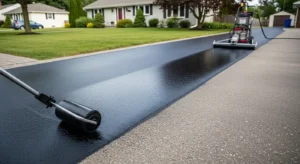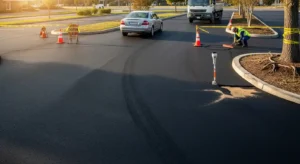Walk on fresh asphalt after 24 hours. You won’t damage it. But don’t park your car yet. Most property owners get this wrong. The surface feels hard, seems ready. Then they drive on it and create dents that never go away. I’ve seen driveways ruined because someone couldn’t wait an extra day. The impressions from tire tracks become permanent features.
How Long Before You Can Use It?
Driveways need 48-72 hours minimum. That’s for regular cars only. No SUVs loaded with camping gear and no moving trucks. Just your daily driver, and even then you’re taking a small risk at 48 hours. For most commercial parking lots, three to seven days is usually enough time before use. Areas with heavy traffic may need a bit longer.
Roads that carry trucks or heavier loads should wait about a week or even up to ten days, depending on how thick the base is and how much weight it needs to support. Hot weather cuts these times down. We’re talking 85°F and above with low humidity. Cold or rain extends them significantly.
A project that would take three days in July might need six in October. Your contractor knows the local conditions and adjusts accordingly. Temperature swings matter too. If it’s hot during installation but drops to 50°F at night, that affects curing rates. The asphalt cools too quickly and doesn’t set properly. Spring and fall bring these challenges more than summer.
Drying Isn’t Everything
Many people get confused because the surface dries quickly, but full curing takes much longer. The top layer may harden in a few days and be fine for walking or light use, but underneath, it’s still soft and settling. The material hasn’t fully strengthened or stabilized yet.
Full curing takes half a year. Sometimes twelve months in colder climates. The binder keeps bonding with stone and aggregate. Strength builds slowly. Resistance to cracking develops over time, not overnight.
You can use the surface before it’s fully cured, but remember it hasn’t reached full strength yet. Heavy vehicles or equipment can leave marks, and too much weight can cause lasting damage. Even small dents may seem harmless at first, but they can trap water. Over time, that water causes bigger problems like cracking, base erosion, and potholes.
Think of it like concrete. You can walk on concrete after a day, but it doesn’t reach maximum strength for 28 days. Asphalt works the same way, just with a longer timeline. The chemical reactions don’t stop when the surface feels solid.
What Changes the Timeline?
Heat speeds everything up. Chemical reactions happen faster when it’s hot outside. The asphalt sets quicker and you can open it to traffic sooner. Cold does the opposite things slow way down. Add humidity and you’re waiting even longer. Moisture in the air affects how quickly solvents evaporate from the asphalt mixture.
Thickness matters too. A two-inch layer dries faster than four inches. The bottom takes time to firm up regardless of what’s happening on top. Heat needs to penetrate all the way through for proper curing.
Different mixes behave differently. Some binders react fast, others take their time. Polymer-modified asphalts cure differently than standard mixes. The aggregate size and type changes how everything bonds together.
Stone dust in the mix can change how well the pavement compacts and how hard it feels at first. Bigger stones make the pavement stronger in the end, but they take more time to settle. If recycled asphalt is used, it may cure a bit faster because part of the material has already aged
The soil underneath the pavement affects how stable it will be. Wet or soft ground can cause problems later, like uneven settling. If the base layer isn’t packed tightly, the asphalt on top won’t stay strong or last long, no matter how much time it has to cure.
Driving on soft asphalt can cause damage you’ll notice later. The weight of your vehicle can leave dents that become permanent once the surface hardens. Turning your steering wheel while the car isn’t moving makes it worse; it can twist and tear the surface.
Keeping Your Pavement in Good Shape
Stay off new asphalt for the first few days to avoid permanent damage. Choosing good weather for installation in summer is ideal, and avoid paving below 50°F.Don’t park heavy vehicles in the same spot during the first year. Move trucks, RVs, and trailers to prevent dents, and use boards under motorcycle kickstands to distribute weight.
Use salt sparingly in the first winter; sand is safer. Wait at least six months before sealcoating to protect against water, sun, and oil damage without trapping moisture. Check for cracks monthly and repair small ones promptly to prevent serious damage.
Ensure proper edge support with borders like concrete curbing, Belgian block, or compacted stone to prevent crumbling.
Actual Usage Timelines
For a home driveway, you can usually drive your car on it after about two days. If the weather is cool or the asphalt was laid later in the day, give it an extra day to be safe. Driveways installed in the morning tend to cure faster because they get more sunlight and warmth throughout the day.
For normal business traffic on commercial lots, wait about a week before driving on the new pavement. Delivery trucks may need a little more time. If you run a retail business, plan for suppliers to use other entrances during this period.
Heavy equipment should wait at least two weeks, or longer if possible. Construction vehicles, forklifts, and anything with outriggers require extra caution because their concentrated weight can easily damage the asphalt.
These numbers come from chemistry, not guesswork. Asphalt needs time to develop its full properties. Skip the wait and maintenance costs skyrocket. You’re not saving time by rushing. You’re creating problems that show up later.
Foot traffic doesn’t cause issues after 24 hours. Let people walk across it. Bicycles are fine too since they distribute weight over a larger area than you’d think. It’s the concentrated loads that cause trouble.
Why Patience Pays Off
Asphalt costs serious money. A driveway runs several thousand dollars. Big parking lots hit six figures easily. Roads cost millions per mile. Wait three extra days now and get twenty extra years later. That’s not an exaggeration. Properly cured asphalt lasts decades. Rushed jobs need replacement in under ten years sometimes.
Think about the long-term cost. A well-built driveway that lasts many years ends up being much cheaper per year. But if the same driveway fails after only a few years, the yearly cost goes up, and you’ll have to pay again for a replacement. On top of that, you have to deal with the hassle of repaving, finding temporary parking, and living with a messy, torn-up driveway.
I’ve seen commercial properties that rushed reopening after paving. Within two years they had ruts in the main drive lanes. The repair cost more than the original installation because they had to mill out the damaged sections and repave. Insurance didn’t cover it because it was a maintenance failure, not an accident.
Looking After Things Long-Term
Inspect regularly once it’s installed. Spot problems before they spread. Small cracks turn into big cracks. Big cracks turn into potholes. Potholes turn into liability issues when someone trips or damages their vehicle. Seal it between six months and a year after installation. Not before—it needs to cure first. Reapply every 2-3 years depending on traffic volume. High-traffic areas need more frequent applications.
Clean oil spills immediately. They eat through asphalt binder like acid. Keep drains clear because standing water destroys pavement faster than almost anything else. Puddles accelerate deterioration by a factor of ten.
Vegetation control matters too. Weeds growing in cracks expand as they grow. Their roots force cracks wider. Kill them and seal the gaps. Tree roots nearby can heave pavement over time. Consider this during initial planning. Power washing helps maintain appearance but don’t overdo it. Too much pressure damages the surface. A light wash annually removes dirt and prevents moss growth in shaded areas.
Setting Up Your Project Right
Book work for late spring through early fall when the weather is stable. Schedule early, as most contractors stay busy during these months. Talk to your contractor about traffic plans and timelines based on your project, mix, thickness, and expected loads. Get it in writing so everyone is clear.
Arrange backup parking and inform anyone using the area to avoid conflicts. For commercial lots, communicate with tenants and customers in advance. For large areas, consider phased installation to keep part of the lot available while work proceeds. Clearly mark completed sections.
Get several quotes, but don’t just pick the cheapest. Check the contractor’s reputation, warranty, and quality of work before deciding.
Ready to Pave Your Property the Right Way?
It takes days for asphalt to dry but months to fully cure. Both steps matter for how well it performs in the long run. Follow your contractor’s timeline, control traffic during the waiting period, and take care of the pavement afterward. These steps aren’t optional; they’re necessary if you want your investment to last.
Do it properly, and your pavement can last 20–30 years or more with good maintenance. Some well-kept asphalt roads have lasted 40 years. Rush it, and problems can appear in just three or four years, which means paying for repairs or replacement again.
At SS Paving, we handle asphalt projects throughout Phoenix, Arizona, from residential driveways to commercial parking lots and everything in between.
We don’t just install asphalt and disappear. Our team guides you through the entire process. You’ll get clear instructions on traffic timelines, curing requirements, and maintenance schedules specific to your project — no guesswork, no confusion.
Get Your Free Consultation
If you are planning a paving project. Contact SS Paving today for a detailed quote and project timeline. We’ll assess your property, answer your questions, and create a plan that delivers decades of performance. Your asphalt investment deserves professional installation and expert guidance. We provide both.
Frequently Asked Questions
How long should I wait before driving on new asphalt?
For a home driveway, wait 2–3 days for standard cars. Commercial lots usually need 3–7 days, and heavy trucks may require up to 10–14 days depending on conditions.
Can I walk or ride a bike on asphalt before it’s fully cured?
Yes, walking and biking are generally safe after 24 hours. Avoid heavy or concentrated loads until the asphalt fully cures.
How does weather affect asphalt curing?
Hot, dry weather speeds up curing, while cold or wet conditions slow it down. Temperature swings can also impact how quickly the asphalt sets.
When should I apply a sealcoat to new asphalt?
Wait until the asphalt is fully cured, usually 6–12 months after installation. Applying it too early can trap moisture and cause damage.
How can I maintain my asphalt to extend its lifespan?
Clean oil spills quickly, repair small cracks, and keep drains clear. Regular maintenance and proper sealcoating help asphalt last 20–30 years or more.






